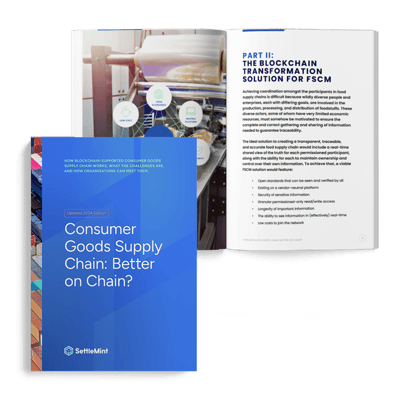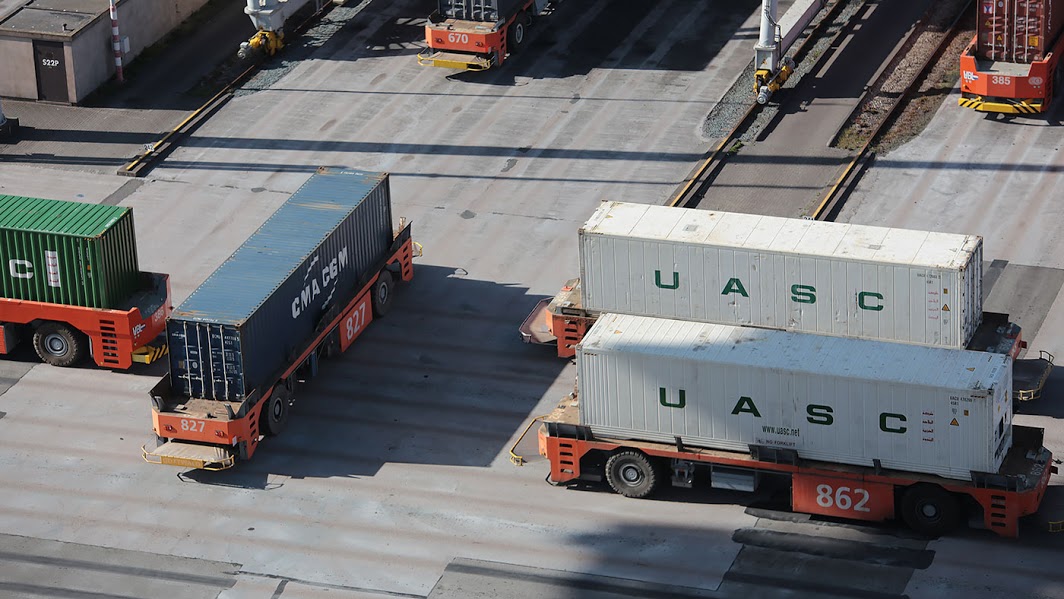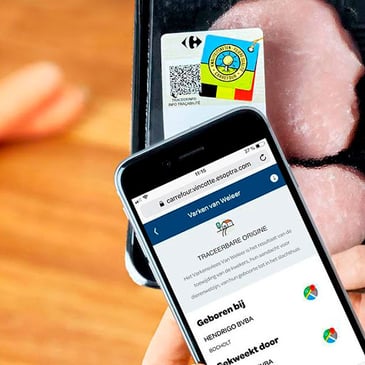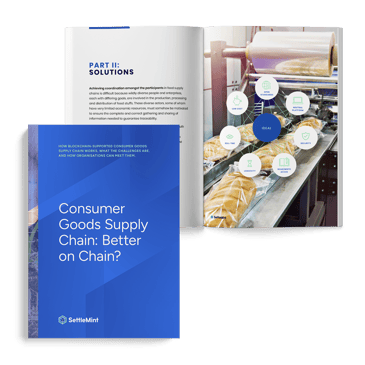Supply chain management
Distributed ledger technologies can dramatically improve operational efficiency in the management of supply chains. Further, the creation of “supply networks” that offer the potential for a universal view, enable advanced supply chain financing, streamlined adherence to regulation, and vastly improved emergency response capabilities in the event of recalls or shortages. Finally, attaching digital identities to physical objects in supply chains provides huge potential for new value-added products and services.
See how SettleMint helped Carrefour bring full transparency to their food supply chain.
Consumer Goods Supply Chain: Better on Chain?
Discover how blockchain drives traceability and sustainability in FMCG supply chains.

How legacy supply chain management systems fall short
Modern supply chains are vulnerable to fraud, suffer from lack of resiliency, and are subject to various inefficiencies that slow down the movement of goods and increase their costs.
Supply chain vs “supply network”
Status quo supply chains are very much chains in the sense that products and information move linearly from one link to the next. This basic structure, however, makes it impossible for links at opposite ends of the chain to communicate directly. It is precisely the lack of communication amongst nodes in supply chains that holds back innovation in supply chain management. The lack of communication makes it difficult or impossible for nodes to coordinate. This results in a low level of supply-chain resiliency, an inability to rapidly and efficiently track and trace items in the supply chain, lack of access to financing for upstream suppliers who remain cutoff from downstream financiers, and a host of other missed opportunities.
A far more efficient way to manage supply chains is through the creation of a network, whereby nodes are connected through multiple routes, rather than through the linear “one-up, one-down” model that is the norm in the status quo of supply chain management.
Factors holding back the creation of a “supply network”
Lack of privacy
Privacy is essential in supply chains because participants need to maintain their commercial advantage. Upstream suppliers, for example, do not want to reveal to end customers information about their operations, pricing, and sourcing because doing so would eliminate their commercial advantage. At the same time, however, there are other nodes in supply chains that benefit from open access to information. Downstream retailers, for instance, can increase the value of the products they sell if there is more information attached to those products. Consumers, after all, are willing to pay more for products they can be sure are authentic and ethically sourced. What’s needed, then, are data management tools that enable supply chain participants to granularly control who gets access to what information and when. Unfortunately, legacy data management tools – which require point-to-point connections – effectively make that impossible because of the excessive resources needed to establish and maintain so many separate connection points.
Security
Legacy systems rely on centralized servers to store and serve data. This structure makes them vulnerable to attack in addition to being non-resilient in the event of a single node experiencing technical failure resulting in data loss.
Regulation
Despite considerable efforts over the last 20 years to digitize supply chain management, modern supply chains remain heavily reliant on paper-based documentation partly because the legacy digital tools have proven insufficient for meeting regulatory guidelines. In many regions, in fact, because trusted and reliable digital alternatives are simply not in place, regulation requires the use of paper bills of lading to be attached to lots and to be reviewed manually by inspectors at various points in the supply chain. This requirement slows down shipments, raises costs, limits financing potential, and increases the risk of fraud. Consider the example of a single shipment of avocados from Mombasa, Kenya to Rotterdam, Netherlands. A 2017 report from IBM and Maersk found that the slow paper-based process for adhering to regulation doubled the time needed to make the shipment and accounted for 15% of the total cost of shipping.
The blockchain solution
Decentralized supply chain management systems that are built on permissioned blockchains overcome the challenges related to security, privacy, and adherence to regulations.
Supply networks
Participants in a supply chain can come together to form supply networks. In such a network, upstream suppliers can audit their data-sharing permissions directly on their own node. For example, universal permissions can be granted for data that supports sustainability measures while permission can be restricted for sensitive data such as the cost paid by a distributor to its direct supplier. Regulators can be granted a universal view of all available data, enabling fast and efficient track and trace in the event of an emergency recall.
Digital identities
Items in a supply chain can be linked to digital identities that are stored in a decentralized network. Public/private key pairs ensure access to associated data for permissioned participants only.

Supply chain management use cases enabled by blockchain
Fast and efficient recalls
The ability to identity defective or unsafe products in a supply chain is critical for maintaining public safety and preventing economic disaster. Consider the example of food supply chains, where the consequences of tainted products are particularly stark. Due to the inadequate trace and trace capacity of legacy supply chain systems, it took, for example, over a month for European investigators to finally determine the exact source of a 2011 European E. coli outbreak. The result was 4000 illnesses and 53 deaths across Europe. The uncertainty as to the source of the outbreak resulted in huge produce wastage and long-lasting stigma for regions that had been suspected as the source. In the end, the European Union was forced to compensate farmers to the tune of 220 million Euros for loss of income due to that single contamination event.
A decentralized blockchain-based database can enable the needed universal view of supply chains. This would provide authorities with near instant capacity to identify tainted or defective products and remove them from the supply chain without relying on mass recalls. Individual nodes in supply chains too would be empowered with the data needed to identify tainted or defective products before passing them down the chain or onto consumers.
Supply chain resilience
Legacy supply chains are extremely vulnerable to disruptions. The “just in time” model, where manufacturers maintain as close to zero inventory as possible in order optimize efficiency, means any disruption in a supply chain can cause downstream manufacturers to grind to a halt within days. In most cases, these downstream nodes have visibility only one step up the chain, meaning they have very little insight into where critical components ultimately come from. Further, as individual nodes in global supply chains have become increasingly specialized, a wide array of downstream value-adding producers are increasingly dependent on base components/ingredients that come from a very small pool of a suppliers. With almost no visibility beyond tier-one suppliers (one step away in the chain), and no universal view of the supply chain for any participant, relatively small upstream disruptions lead to cascading downstream disruptions.
A blockchain based supply network that provides granularly permissioned universal visibility enables participants to anticipate disruptions and plan alternatives accordingly. In the event of a supply chain emergency, for example, authorities could have insight into the scale of the emergency, allowing them to take the steps needed to avoid catastrophe.
Supply chain finance
In supply chains, financing must flow upstream from end users to retailers, on to distributors, then manufacturers, and finally to the source, suppliers. As a rule, downstream nodes in a supply chain (those closer to the end buyer) have better access to financing with more agreeable terms. That’s because these downstream nodes are closer to well-funded financial institutions, and so they are able to provide the information needed to satisfy the reporting requirements and risk management protocols of financiers. Particularly in cross border supply chains, and especially where upstream nodes are located in emerging markets, financing can’t move efficiently upstream because there’s no direct connection between the upstream nodes and the financiers. Legacy supply chain data management systems typically provide each node at best a “one-up, one-down” view of the supply chain. Further, even where financiers have a direct connection to a node in a supply chain, legacy systems require the verification of paper documents, a process that can take as long as four months for a single loan.
Blockchain enables the digitization of the entire trade finance cycle. In addition to providing upstream suppliers with much needed capital, a digitized trade finance ecosystem built on blockchain offers efficiency improvements including faster processing times, less human error, and reduced risk of fraud. For financiers, the end result should be lower capital requirements and less counterparty risk.
Read more on how blockchain can be applied to banking and financial services
Anti-counterfeiting
Counterfeiting is now the largest criminal enterprise in the world, accounting for 3.3% of total world trade according a 2019 report from the OECD. For the European Union, the counterfeit trade currently represents nearly 7% of imports from non-EU countries, up from 5% in 2013. Almost no industry is immune to counterfeiting but the biggest share of seizures in dollar terms have historically been in footwear, clothing, leather goods, electrical equipment, watches, medical equipment, perfumes, toys, jewelry and pharmaceuticals.
Attaching a digital identity, in the form of a non-fungible token, to a physical object enables not only the tracing of the object from production to sale, but also the transfer of ownership of that object as it moves along the chain. Digital identities can be linked to QR codes that are placed on lots and/or individual packages. This makes it possible for distributors, retailers, resellers, and consumers alike to easily verify that they are holding authentic products, and to easily transfer ownership of the product.
Post-sale engagement
Attaching a digital identity to a product also provides opportunities for value-added customer engagement. For example, a buyer, when verifying the authenticity of a product by scanning its QR code, can be presented with unique branded content and other marketing material.
Post-sale service
Linking products with a digital identity also makes it easier to develop post-sale services like warranties and maintenance. For example, a warranty period can automatically be started the moment the first buyer verifies the product’s digital identity. In addition to simplifying warranty-related maintenance protocols, this would also serve to retain a product’s value in secondary markets.
Enhanced sustainability
Legacy supply chain management systems make it next to impossible to monitor and enforce sustainability goals in supply chains. Consider just one goal: the elimination of child labor. A report from the International Labor Organization finds that, due to the lack of visibility into supply chains, child labor is widespread in the food and textile industries. The report estimates there are over 150 million children currently in the labor market.
Supply chains supported by blockchain technology can offer full visibility into the provenance of components used the chain. This has the potential to support sustainability goals through both individual choice and regulatory oversight. Regarding the former, a consumer may be willing, for example, to pay more for tea that can be verified as having been grown organically by workers who have been compensated fairly and work in safe conditions. In terms of the latter, with more complete regulatory oversight in place, nodes in the supply chain may be obligated to prove that products they handle adhere to sustainability goals.


